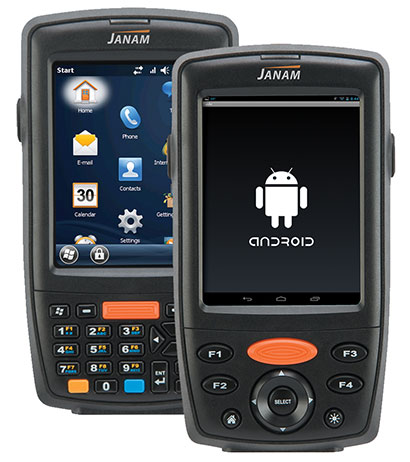Janam is a New York-based rugged mobile computing vendor with worldwide distribution. The company was established in early 2006 as a provider of purpose-built rugged handheld computing devices for mobile workers. The XM Series of Windows-based rugged PDA-style mobile computers was initially introduced in late 2009 to answer the need for compact, versatile, rugged, pocketable and reasonably priced industrial handhelds. On December 9, 2015, Janam introduced the dual-OS capable XM70 as an updated and more powerful version of the existing XM66.

What's new and different between the old XM66 and the new XM70? In terms of exterior look and design, nothing. And the XM70 runs still Windows Embedded Handheld 6.5. That's certainly not a new OS, but it remains a viable and widely supported legacy platform. It's probably fair to say that WEHH 6.5 remains Microsoft's small form factor OS of choice for however long it takes Microsoft to make the case for switching to Windows 10 IoT Core. And that could be a while.
But WEHH 6.5 is not all the new XM70 can run. The device also supports Android "Jelly Bean" 4.1.2. What that means is that Janam offers a rugged, high-quality, attractively priced device that not only covers legacy and current enterprise requirements but also allows experimenting with and possibly migrating to Android without the expense of new hardware. An interesting proposition indeed.
In terms of hardware, the XM70 remains a traditional rugged handheld with a 3.5-inch 240 x 320 pixel QVGA stylus-operated display. It can be ordered either with a classic backlit PDA keypad (just function keys, nav pad and scanner button) or with a backlit numeric keypad for more rapid data entry. Under the hood, however, things have changed. Here, Janam replaced the venerable 533MHz Freescale i.MX31 chip of the older XM66 with a non-specified 1GHz ARM Cortex-A8 application processor said to at least double performance. RAM is up to 1GB and onboard storage to 4GB. There is also a user-accessible micro-SDHC card slot for extra storage. Wireless communication has also been upgraded. There's now Bluetooth 4.0 and (optional) 802.11a/b/g/n WiFi.
Things have changed in the scanning department as well. Instead of the Adaptus CMOS imager of the XM66, the XM70 comes with a 1D/2D Zebra SE4500 scanner can read and decode a large variety of 1D and 2D codes and symbologies.
In terms of size, the XM70 still measures 3.1 x 5.75 x 1.3 inches and weighs about ten ounces. That's makes the device easily pocketable. Considering the substantial ruggedness of the platform and the fact that it also includes an industrial quality 1D/2D CMOS imager, that's quite remarkable.
Like the older XM66, the new XM70 can survive multiple four-foot drops onto concrete, carries IP54 sealing, and can handle a wide operating temperature range from 14 to 122 degrees Fahrenheit.
There's a beefier standard Li-Ion battery and a powerful optional extended battery. And since the design of the XM70 hasn't changed, the new unit is fully compatible with existing XM66 accessories.
With the XM70, Janam is not only extending the life of their popular XM66 platform (Janam says hundreds of thousands of mobile workers are using them), but also provides the opportunity to explore alternate operating systems strategies. That makes a lot of sense. Android has a dominant market share in smartphones, but it's still possible that Microsoft's Windows 10 IoT finally proves to be a viable migration path for all those existing Windows CE and Windows Mobile apps and systems. Janam XM70 customers will be ready for both outcomes.
Janam Technologies LLC · janam.com · 1-516-677-9500






